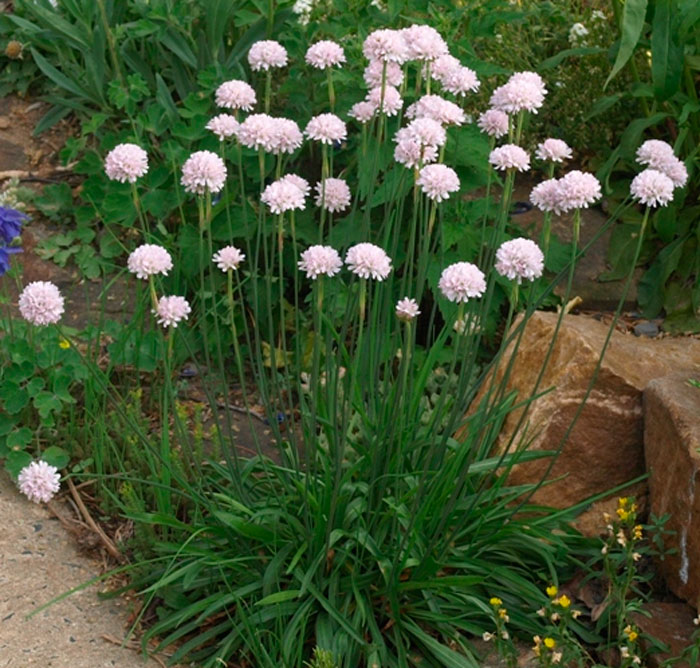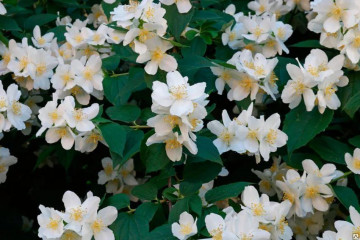Armeria flower - planting and care, varieties
Content:
Armeria flower is a beautiful perennial, with dense buds of various colors. Used to decorate flower beds. Looks best on alpine slides and near ponds.
Description of armeria: varieties and varieties
The plant has about 90 species, but the most successful are 10 varieties of the flower. They take your breath away with a delicate simplicity that stands out against a backdrop of pompous colors.
Alpine armeria - height up to 15 cm, diameter up to 30 cm. Inflorescences are axillary and capitate, with a diameter of about 30 mm. Flowering occurs in early June. Duration - from 3 to 4 weeks. Leaves can persist even with the onset of severe cold weather.
The color is pale, each of the varieties has its own color variations:
- Alba - white color;
- Rosea - deep pink buds;
- Laucheana - the petals are painted in a carmine shade.
Armeria beautiful or pseudo-armeria - the height of the bush is about 40 cm. The leaves are evergreen. Inflorescences are collected from many small flowers. Blooms from early June to late August. Varieties:
- Bees Ruby - bush height 60 cm, rich shade buds.
- Joystick White - spherical inflorescences are painted in light colors. The variety is often cultivated as an annual.
- Thrift is a low-growing bush up to 20 cm high, light petals.
- Red planet - the name speaks for itself, these are light burgundy flowers, the height of the peduncles is 30 cm.
- Ballerina Lilak - painted in delicate fuchsia.
Armeria maritima naturally grows on the seashore. Height - 20 cm. Rosette diameter - 20 cm. The color of the petals has a lilac tint. Blooms in May, pleases with its colors for 2.5 months. Repeated blooming in autumn is possible if favorable conditions are created. Varieties:
- Bloodstone - burgundy petals;
- Dusseldorf Stolz - dark fiery buds;
- Armeria Louisiana - light purple flowers;
- Vindictive - the petals are painted purple;
- Armada White is a snow-white bloom.
Armeria juniper - naturally grows in the highlands of Portugal and Spain. The height of the bush is small - 15 cm. The diameter of the inflorescences is up to 20 cm. Differs in abundant flowering. Sometimes the buds completely overlap the leaves. Blooms in July, pleases with lush buds for 45 days. Varieties:
- Brno - lilac;
- Bivenz Variety - delicately lilac petals.
Armeria garden (ordinary) - the height of the bush is about 60 cm. The color of the petals is light carmine.
Armeria beautiful is an evergreen shrub that looks a lot like grass. It is recommended to plant it among stones and artificial rocks, near ponds, to separate the boundaries of paths with bushes. The most popular flower of this variety is Anna Maria. It reaches a height of about 30 cm. The petals can be of different colors - both carmine and snow-white.
Other plant varieties that even a novice florist can easily grow in their area:
- The buds of Siberian armeria are small, no more than 2 cm in diameter. It blooms in June, the buds last 40 days. Homeland - Eastern Siberia.
- Arctic - rarely domesticated. At 2 years of age, natural dying off occurs. The flowers resemble a bulbous inflorescence.
- Armeria ballerina red - very similar to a carnation.The diameter of the inflorescence does not exceed 4 cm, the height of the plant is from 20 to 25 cm.
- Vilcheva - bush height up to 25 cm, leaf length - 10 cm, width 5 cm.
The culture is very unpretentious. Regardless of the subspecies, it can be easily grown in gardens and decorate flower beds and alpine slides with ponds.
Planting site, soil
Armeria flower is perennial, loves well-lit areas. The soil should be low to medium acidity.
To achieve the desired alkalinity of the earth, you can add acetic acid and ammonium nitrate to it. The ideal landing site is a rocky, sandy loam substrate. If this is not in the garden, you can create it yourself. To do this, you need to prepare a mixture of turf, greenhouse land and river sand, which are mixed in equal parts.
Sowing seeds in open ground
You can sow seed into the soil in late autumn, or in spring (from the first days of March). If growing for seedlings in a greenhouse, the appropriate time for this is February and early March.
The grains are not buried in the soil. They are covered with earth, the layer thickness is 5 mm. It is not necessary to water the soil heavily; it is recommended to moisten it abundantly through a spray bottle.
Planting Armeria seedlings in open ground
A method of planting a flower through germinated seedlings is preferred. To increase the likelihood of gathering, it is recommended to put the grains on the side shelf in the refrigerator a week before planting. Immediately before disembarking, they must be filled with warm water for 6 hours.
Prepared grains are placed in fertile soil, covered with earth and placed in a warm place. The earth must always be kept moist.
When the seedlings have 3 full leaves, they can be planted in the soil.
Disembarkation is carried out in the spring at a time when the frost will not return. The soil is well moisturized and slightly acidic. The distance between the bushes is at least 30 cm. If you plan to plant the bushes with a continuous thick carpet, the distance between the holes is 15 cm. The leaves of the flower should not sink into the ground. After lowering the seedling into the hole, it is covered with earth, compacted and watered. The first 20 days after planting, watering should be regular, but in between, the soil should be allowed to dry.
Watering and loosening the soil
Armeria planting and leaving in the open field is not difficult. The main thing a plant needs is regular watering. The hotter it is outside, the more often you need to give the flower water. The soil should dry out between waterings, but not dry out.
Loosening is regular, carried out as the earth is tamped around the flower. The looseness provides oxygen to the roots, which promotes vigorous growth and abundant flowering.
Reproduction methods
Flower reproduction is carried out arbitrarily, by division and cuttings. It is possible to separate the bushes in order to grow a full-fledged plant from them only on flowers from 2 years old. The bush is dug up and divided into separate fragments. Each part must have a well-developed root system.
The grafting procedure is simple - a young rosette without roots or with a poorly developed root system is separated from the sod. The stalk is planted in the ground with good drainage, from above it is closed with a cap, the function of which can be performed by a plastic bottle.
The stalk is under the hood from 1 to 2 weeks. Watering is regular. Rooting takes place in a fairly short period of time.
The plant reproduces well by self-sowing, flower grains are actively carried by the wind and settle into the soil. Therefore, if there is already a planted plant on the site, it makes no sense to propagate it by cuttings. But if an increase in the number of culture is not planned, the boxes after they ripen must be closed with gauze folded in several layers. This is the only way to prevent the independent spread of flowering bushes.
Top dressing and transplanting
Planting and caring for an armeria is within the power of even a novice florist. The plant needs to be fed, which ensures a regular and lush flowering.
Top dressing is carried out at intervals of 1.5 months. Complex mineral fertilizers are used. The prepared solution must be poured into the ground instead of water.
Recommended feeding preparations:
- "Polygro Universal" - in the composition of potassium and nitrogen, magnesium and phosphorus, a number of trace elements.
- "Humate +7 iodine" - includes a standard set of mineral elements, additionally includes iodine, humic acids and sulfur. The drug helps to activate and strengthen the immune system.
- Fertika Lux is one of the most popular fertilizers, which contains all the mineral and nutritional elements necessary for the plant.
Transplanting is an important nuance in flower care. The first division of the bush is carried out when he turns 5 years old. The bush is divided into several parts, each of which is planted in a new place. In the future, transplants are carried out at a frequency of 1 time in 2-3 years. If this is not done, the flower will overgrow and lose its attractiveness.
Pruning armeria
To care for a flower correctly, it must be pruned periodically. It is important to remove dry branches and leaves in a timely manner.
The main pruning is done after the active flowering of the bush is completed. A sharp secateurs are used. You need to remove wilted buds, weak branches, sluggish leaves. The procedure will help stimulate the second flowering of the plant.
Pests and diseases
Caring for the armeria is simple. Practically unaffected by pests and diseases. The only insect that a flower can choose is aphid.
If aphids are found on the bushes, the soil around the plant should be sprinkled with tobacco dust. An infusion of tomato tops will help get rid of the insect.
Long-term Armeria cannot stand the presence of alkali in the earth. A sign of insufficient soil acidity is the appearance of spots throughout the plant. You can only fight this problem by pruning the bush and acidifying the land.
Root rot occurs due to stagnant water, abundant flooding of roots, insufficient drainage. To reanimate the plant, the bush must be dug up, the damaged parts of the root system must be cut off and transplanted to another place, following all the recommendations.
How to prepare for wintering
The flower tolerates winter well even with very low temperatures, but provided there is a sufficient amount of snow, which covers the bushes and protects them from negative factors.

It is necessary to close the plant for the period of cold weather so that the branches do not freeze
If there is little snow, the plants should be covered with fallen leaves or spruce branches. Non-woven fabric or dry peat can be used for shelter. With the onset of the first warm spring days, the bush must be opened.
Flowering period and care after
When the plant blooms, watering should be increased and the ground should be loosened. At the end of flowering, drooping buds are cut off.
Use in landscape design
The beautiful lush flower is widely used in landscape design. The plant looks best in rock gardens and among rocky gardens and masonry. The dense leaves will be a bright decoration of the garden all year round.
Recommended to combine with low flowers, such as bells, phlox, thyme and saxifrage. The combination of several varieties with different shades of petals looks great.
It is difficult, among all the variety of plants and flowers, to find such a gentle creature as armeria - unpretentious in care, not prone to diseases and breeding well. This herbal plant will become the queen of any flower bed, bringing notes of graceful luxury to even the most modest exterior.





















